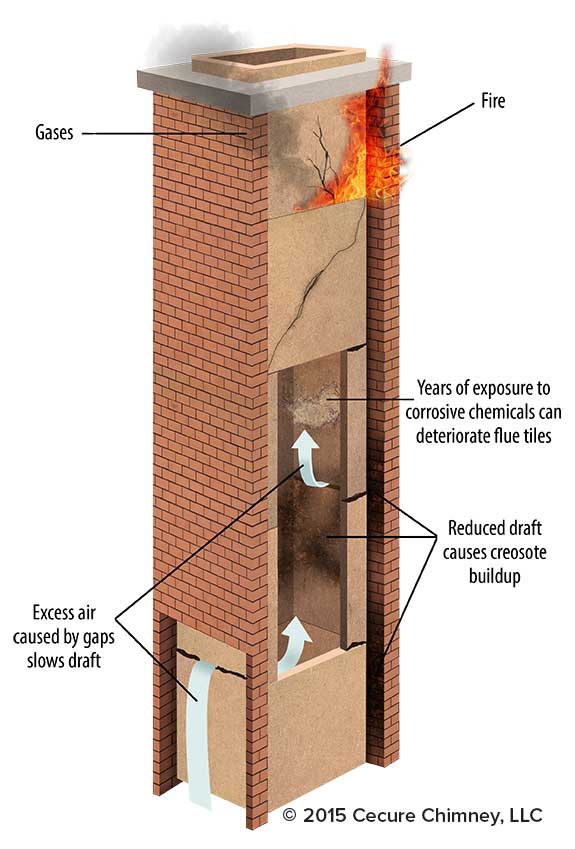We Offer Effective & Durable Chimney Relining Services To Arlington, TX & The Surrounding Areas
Trouble with smoke, draft, and performance, and an increased risk of house fire – all of these are issues associated with a damaged flue liner. Traditionally made of clay tiles, flue liners can crack and fall apart, and the mortar joints that hold the tiles together can recede, crack, crumble, or develop holes.
As the fire in your fireplace burns, it generates high temperatures along with corrosive gases and byproducts. Over time, these elements can seep through any cracks or holes in the structure, leading to damage in the masonry or wood framing of your chimney, as well as nearby walls and ceilings. This transfer of heat can also lead to a house fire and poisonous gases like carbon monoxide can make their way into the very air you breathe.
With all the dangers and damage associated with a deteriorating flue liner, it’s important to know what kind of condition yours is in. That’s why we stand with the National Fire Protection Association (NFPA) and the Chimney Safety Institute of America (CSIA) and their recommendation that homeowners schedule annual chimney evaluations with a reputable company.
If you haven’t booked your yearly chimney evaluation with Black Velvet Chimney yet, set up an appointment online.

What Is a Flue Liner?
A flue liner is a protective barrier that extends the length of your chimney flue. It safeguards your home from fire by containing heat and the toxic fumes it produces. It also prevents sparks or embers from escaping into cracks in the masonry which significantly reduces the risk of chimney fires.
Flue liners weren’t standard before 1940 so If you have an older home, your chimney may not be lined at all. If this is the case, having your chimney lined is not only a matter of safety, but it can also extend your chimney’s lifespan and save you money in the future. Flue liners protect the chimney itself from the corrosive byproducts of combustion. Unlined chimneys and those with damaged liners can deteriorate due to acidic gases which can result in expensive masonry repairs.
What Are the Signs of a Damaged Chimney Liner?
A damaged chimney liner might not always be obvious, and you may not become aware of a problem until it’s too late. However, there are some early warning signs you can watch out for:
- Rusting and other signs of water damage. Water intrusion can damage all types of flue liners. If you have a metal liner, check for rust on the liner or water stains around the base of the chimney.
- Smoke is backing up into your home. An intact and functioning flue liner should vent smoke and fumes efficiently. If you experience smoke entering your living space when using your fireplace, it could indicate a damaged liner that isn’t able to exhaust smoke properly.
- There is debris in the firebox. Have you found bits of tile, clay, or metal flakes accumulating in your fireplace? These could be broken pieces from a deteriorating flue liner.
- The fireplace has an unusual smell. New odors can point to several chimney problems including a damaged flue liner. If you notice a change in smell, schedule a chimney evaluation to get to the bottom of the cause.
- The bricks are discolored. When a flue liner has cracks and gaps, it’s easier for water to seep in. A common sign of water damage is a white, powder substance known as efflorescence.
Ask About Our Relining Options
We conduct chimney evaluations using video scanning equipment so we can see the entire flue liner from top to bottom, leaving nothing to guesswork or assumption. If we find any damage, we’re pleased to offer our customers in the Dallas/Fort Worth area the most effective and reliable repair and relining options:
- HeatShield®. Trusted by chimney professionals for years, HeatShield® is a revolutionary liner repair/reline system. This cerfractory sealant system allows us to effectively patch and seal cracks and smooth over deteriorating surfaces, adding strength and heat protection. HeatShield® also boasts an option that involves both the cerfractory sealant and a sleeve liner for additional reinforcement and security. Whether you have a few cracks here and there or you need to have your entire flue resurfaced, HeatShield® can help.
- FireGuard. Like HeatShield®, FireGuard is a liner repair/resurfacing system that can strengthen and restore damaged clay tile liners. It’s a ceramic repair system that uses pinpoint vibration to ensure that every last crack, hole, or gap is filled and sealed completely. What makes it different? Aside from the use of vibration, what makes this system different is its ability to withstand temperatures as high as 3,205 degrees Fahrenheit and its ability to protect against thermal shock, gas transfer, and heat transfer. If your liner is damaged, FireGuard is a great restoration option.
- Stainless Steel. Many homeowners opt to have their clay tile liners relined with stainless steel, which is an incredibly durable metal that’s capable of standing up to the heat and moisture produced by the fire, time and time again. These liners are perfectly fitted to the chimney and carry a lifetime warranty when professionally installed and maintained, which makes them appealing to many homeowners.
All of our liner repair and relining options are approved for use with all fuel types. No matter which option you choose, you can continue enjoying your favorite fuel for keeping you and your family warm.
Turn to Black Velvet Chimney for Your Relining Needs
To learn more about our chimney relining services or to request an evaluation or a chimney reline, simply request more information online. We look forward to hearing from you and helping you keep your chimney in excellent condition, season after season.
For chimneys that qualify, HeatShield® is a great chimney relining option. It’s always good to have great options when it comes to chimney repair, don’t you think?
